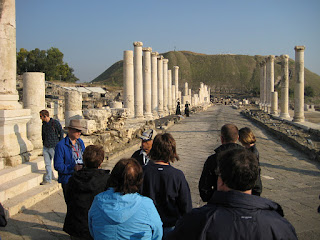Alright, truth be told, I always try to end my Israel trips
in Jerusalem. There is just something so
powerful about capping a visit to the Holy Land with arrival and touring in
Jerusalem that is hard to explain if you haven’t done it. Every stop has its highlights and the
excitement and learning grow along the way, but it comes to a boil in
Jerusalem, where you are confronted with powerful evidences of biblical
reliability over and over again. You
walk the streets of the Old City on pavement stones from the time of Jesus on
your way to places you know he walked and stood. You see places you’ve read about in
Scripture, you discover locations and geography that explain things you’ve read
in the Bible, and you cannot escape thinking about spiritual realities in a
city that has been claimed by three major world religious systems. The history is palpable, the culture is
explosively diverse, and the chance to experience Israel’s spiritual capital in
both its ancient and modern neighborhoods ought not to be missed.
Thus far we have done just about everything you might
associate with a visit to the city, and what we haven’t done yet we’ll do in
our final day tomorrow, it seems. Standing
on the Mount of Olives, walking the Palm Sunday road, praying and singing in
the Garden of Gethsemane, visiting nearby Bethlehem, and catching up with
Shaban, my favorite Old City shopkeeper, were highlights of day one. Visiting the Western Wall, a walk through the
Western Wall tunnel, visiting the city of David, hikes through either
Hezekiah’s or a Canaanite Tunnel from Gihon Spring, and experiencing Yad
Vashem—Israel’s Holocaust memorial—were day two’s highlights. The Temple steps and Temple Mount, followed
by visits to the Church of the Holy Sepulcher and a closing communion in the
Garden Tomb marked the last day. I can
barely get that list typed without being overwhelmed by the remembrances or
anticipations that come with each. How
do I describe how you feel seeing a stone pavement where Jesus was mocked and
tortured for me? There is nothing I can
say that is serious or powerful enough.
And it is like that all day, every day here.
It is moments like this that keep me leading trips and
encouraging people to come if they can.
There simply is nothing like what you experience when you are here. And it is frustrating to try to explain that
to others who haven’t had the experience.
So, I think I will just leave it with this—I am so blessed to be here
and to have the privilege of sharing it with those who are here.
 |
| Our group on the Mount of Olives, half way down the Palm Sunday Road |
Now I’m in the airport, awaiting our flight home. It’s late, I’m tired, and we have a 12 hour
flight to Philadelphia next. But it is
all more than worth it, and the dominant feeling I have and that will carry
through the next weeks is wonder. It is
truly “wonder” full to be here, and if the Lord tarries, I hope to visit here
again.


















